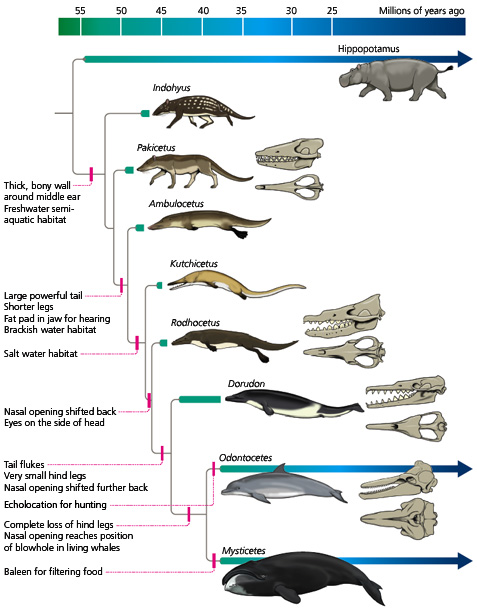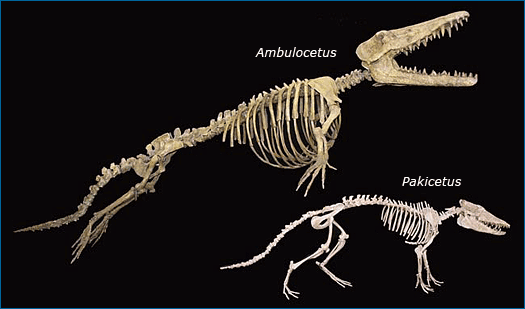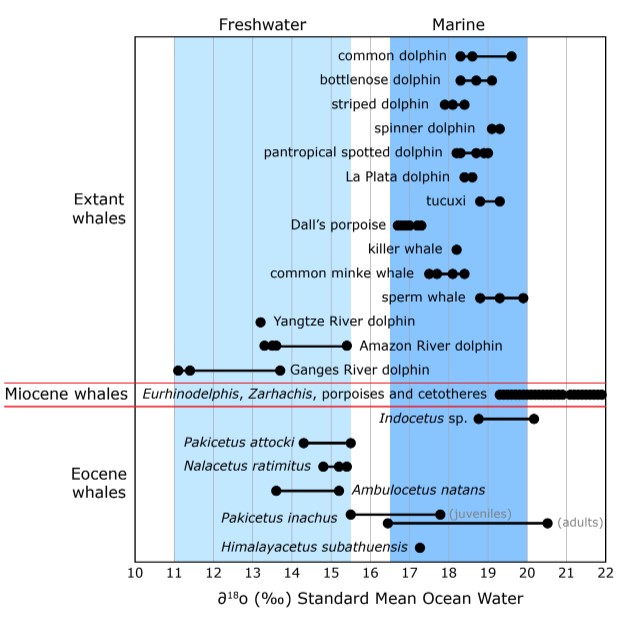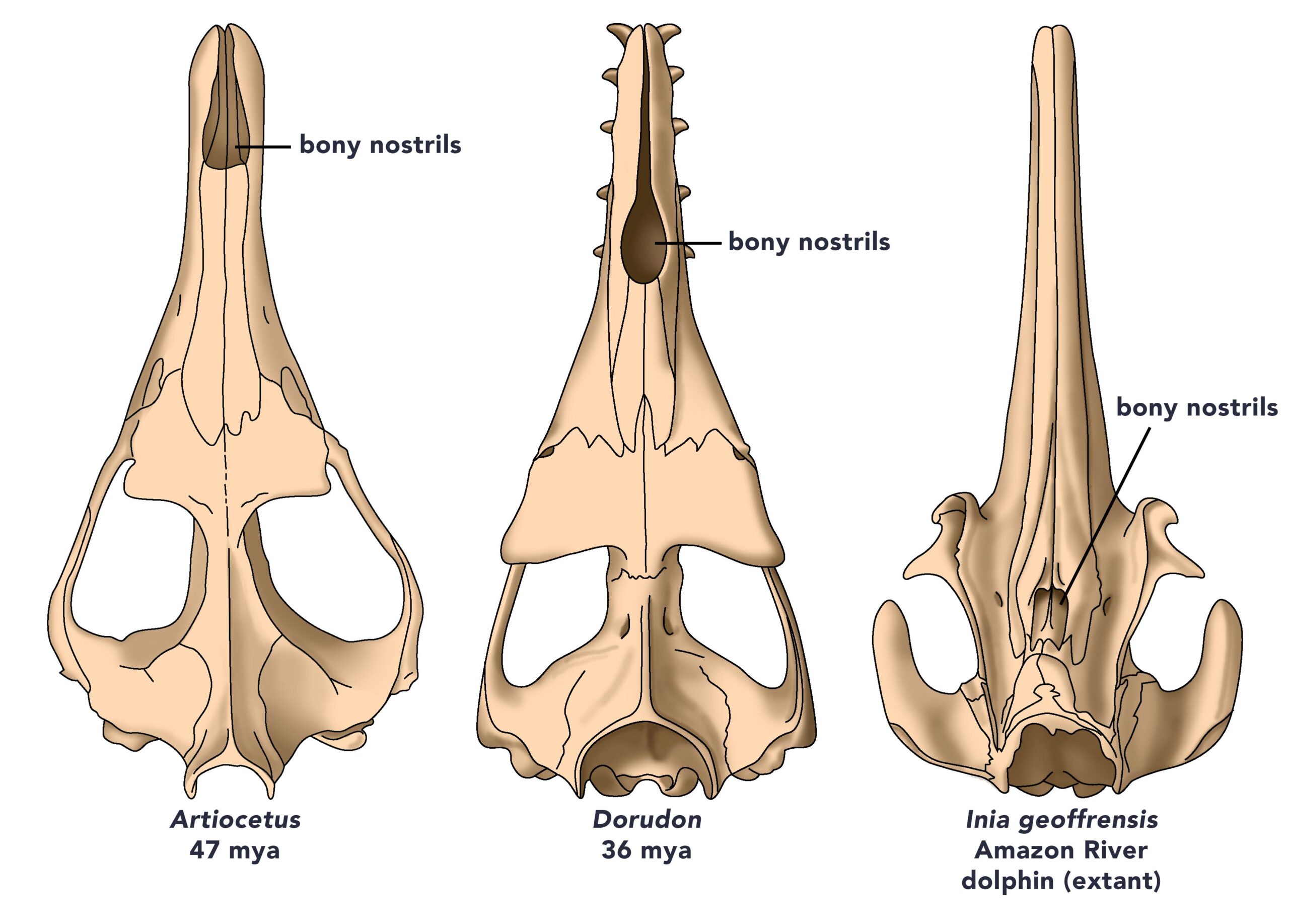Which Change In The Evolutionary History Of Horses Is Documented By The Fossil Record?
The first affair to notice on this evogram is that hippos are the closest living relatives of whales, just they are not the ancestors of whales. In fact, none of the individual animals on the evogram is the directly antecedent of whatsoever other, as far as we know. That'south why each of them gets its own branch on the family tree.

Hippos are large and aquatic, like whales, but the two groups evolved those features separately from each other. We know this considering the ancient relatives of hippos called anthracotheres (non shown hither) were non large or aquatic. Nor were the ancient relatives of whales that you lot come across pictured on this tree — such equallyPakicetus. Hippos likely evolved from a group of anthracotheres about 15 one thousand thousand years agone, the first whales evolved over l million years ago, and the ancestors of both these groups were terrestrial.
These first whales, such asPakicetus, were typical state animals. They had long skulls and large teeth that could be used for eating meat. From the outside, they don't look much like whales at all. However, their skulls — particularly in the inner ear region, which is surrounded by a bony wall — strongly resemble those of living whales and are unlike those of whatever other mammal. Oft, seemingly small-scale features provide critical evidence to link animals that are highly specialized for their lifestyles (such as whales) with their less farthermost-looking relatives.

Compared to other early whales, likeIndohyus andPakicetus,Ambulocetus looks like information technology lived a more aquatic lifestyle. Its legs are shorter, and its hands and feet are enlarged like paddles. Its tail is longer and more muscular, too. The hypothesis thatAmbulocetus lived an aquatic life is as well supported by testify from stratigraphy —Ambulocetus'due south fossils were recovered from sediments that probably comprised an aboriginal estuary — and from the isotopes of oxygen in its bones. Animals are what they eat and drink, and saltwater and freshwater have different ratios of oxygen isotopes. This ways that nosotros tin can acquire about what sort of water an creature drank by studying the isotopes that were incorporated into its bones and teeth as it grew. The isotopes show thatAmbulocetus likely drank both saltwater and freshwater, which fits perfectly with the idea that these animals lived in estuaries or bays between freshwater and the open bounding main.

Whales that evolved afterAmbulocetus (Kutchicetus, etc.) testify even higher levels of saltwater oxygen isotopes, indicating that they lived in nearshore marine habitats and were able to drink saltwater as today's whales can. These animals evolved nostrils positioned further and further back along the snout. This trend has continued into living whales, which have a "blowhole" (the outside opening to the bony nostrils) located on pinnacle of the caput to a higher place the eyes.

These more aquatic whales showed other changes that also suggest they are closely related to today'due south whales. For example, the pelvis had evolved to be much reduced in size and divide from the backbone. This may reverberate the increased utilise of the whole vertebral column, including the back and tail, in locomotion. If you watch footage of dolphins and other whales pond, you'll discover that their tailfins aren't vertical similar those of fishes, but horizontal. To swim, they motion their tails up and down, rather than dorsum and forth equally fishes practice. This is because whales evolved from walking land mammals whose backbones did non naturally curve side to side, but up and down. You can hands meet this if you watch a dog running. Its vertebral column undulates upward and down in waves every bit it moves forward. Whales do the same thing as they swim, showing their ancient terrestrial heritage.
Every bit whales began to swim by undulating the whole body, other changes in the skeleton allowed their limbs to be used more for steering than for paddling. In the skeletons of living dolphins and whales, the transition from body to tail fluke is marked by a change in their vertebral cavalcade: trunk vertebrae are taller than they are wide, and tail fluke vertebrae are wider than they are alpine. We meet the same pattern in fossils from early basilosaurid whales, similarDorudon andBasilosaurus, and so know that they had flukes that could help ability swimming. They also had other skeletal changes that suit an aquatic lifestyle. Their elbow joints were flexible, dissimilar living whales, only able to lock, allowing the forelimb to serve as a better control surface and resist the oncoming menses of h2o as the animate being propelled itself forward. The hindlimbs of these animals were about nonexistent. They were and then tiny that many scientists call up they served no constructive function and may have fifty-fifty been internal to the trunk wall. Occasionally, we discover a living whale with the vestiges of tiny hindlimbs inside its trunk wall.

These vestigial hindlimbs are evidence of basilosaurids' terrestrial heritage. The picture below on the left shows the central ankle bones (called astragali) of three artiodactyls, and y'all tin see they accept double caster joints and hooked processes pointing upwardly toward the leg-bones. Below on the correct is a photograph of the hind pes of a basilosaurid. Y'all tin can encounter that it has a consummate ankle and several toe bones, fifty-fifty though it can't walk. The basilosaurid astragalus notwithstanding has a caster and a hooked knob pointing upwards towards the leg basic equally in artiodactyls, while other bones in the ankle and foot are fused. From the ear bones to the talocrural joint bones, whales belong with the hippos and other artiodactyls.
Reviewed and updated, June 2020.
Isotopic analyses information from:
Bajpai, S., and P.D. Gingerich. 1998. A new Eocene archaeocete (Mammalia, Cetacea) from India and the time of origin of whales.Proceedings of the National Academy of Sciences 95:15464-15468.
Barrick, R.E., A.G. Fischer, Y. Kolodny, B. Luz, and D. Bohaska. 1992. Cetacean os oxygen isotopes as proxies for Miocene ocean compostion and glaciation.Palaios 7(5):521-531.
Thewissen, J.Thou.M., L.J. Roe, J.R. O'Neil, Southward.T. Hussain, A. Sahni, and S. Bajpai. 1996. Development of cetacean osmoregulation.Nature 381:379-380.
Yoshida, Due north., and N. Miyazaki. 1991. Oxygen isotope correlation of cetacean bone phosphate with environmental water.Journal of Geophysical Research 96(C1):815-820.
Source: https://evolution.berkeley.edu/what-are-evograms/the-evolution-of-whales/
Posted by: leverettfainizind.blogspot.com

0 Response to "Which Change In The Evolutionary History Of Horses Is Documented By The Fossil Record?"
Post a Comment